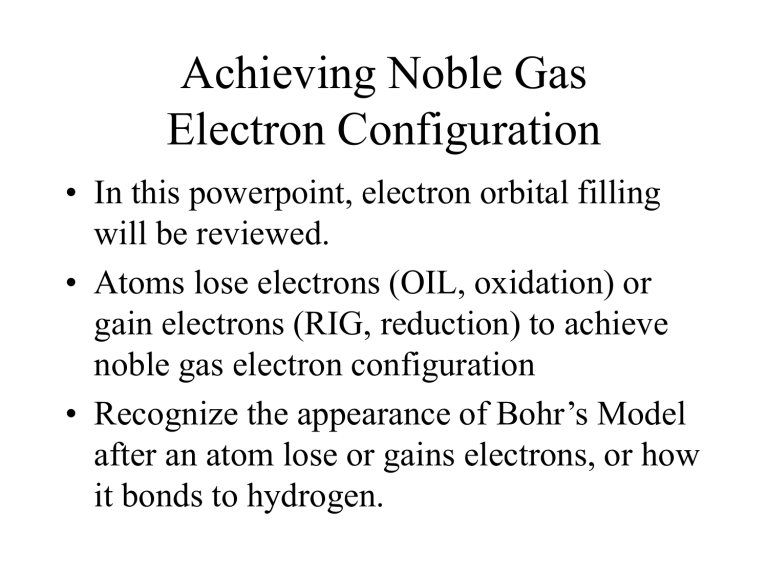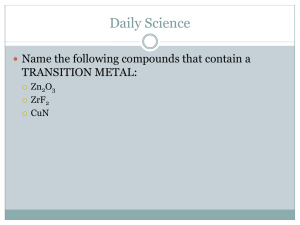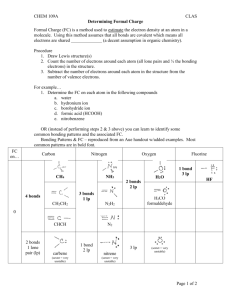Achieving Noble Gas Electron Configuration

Achieving Noble Gas
Electron Configuration
• In this powerpoint, electron orbital filling will be reviewed.
• Atoms lose electrons (OIL, oxidation) or gain electrons (RIG, reduction) to achieve noble gas electron configuration
• Recognize the appearance of Bohr’s Model after an atom lose or gains electrons, or how it bonds to hydrogen.
Supplemental packet page 53
Electron Orbital Filling
9e
10e
11e
10e
10e
Hunds rule needs to be applied:
Fill each p orbital with one electron each before pairing.
F- and Na+ are isoelectronic (the same electronically) with Ne
All elements lose or gain electrons to achieve noble gas e- configuration
Draw the following into your notes opposite page 64 nonmetals gain electrons to achieve noble gas e- configuration
•
•
•
5
B
•
• • •
•
•
•
6
•
C
•
•
• • •
• •
10
•
•
Ne
• •
• •
7
•
•
•
•
N
• •
8
•
•
O
•
•
• •
•
•
•
9
F
•
• • semimetal C 4 – carbide ion
N 3– nitride ion
O 2– oxide ion
F – fluoride ion nonmetals ions
•
Draw the following into your notes opposite page 64
Formation of Ions from Elements
Cation, X + , Formation Oxidation ( OIL ) oxidation is loss of electrons
Anion, X – , Formation Reduction ( RIG ) reduction is gain of electrons
This is a html hyperlink to a web QuickTime movie tutorial.
If QuickTime movie player is not installed on your computer the link will not work.
http://www.sdmesa.sdccd.net/~dgergens/chem100/lewis_dot/_atomic_e_dot.html
Re-Draw the following into your notes opposite page 64 nonmetals bond to hydrogen to achieve noble gas e- configuration
•
Addition of hydrogen’s
•
•
•
5
B
•
•
1
H • •
6
•
H
•
•
•
•
C
•
CH
4 methane gas
H • •
• •
10
•
•
Ne
• •
• •
7
•
H
•
•
•
N
NH
3 ammonia gas
Achieving an OCTET valence
(eight electrons in the outer most atom shell)
H • •
8
•
•
•
•
O
•
•
•
•H
H
2
O water
•
9
F
•
• •
HF hydrogen fluoride molecules of nonmetals hydrides
Circle nonbonding pairs of electrons
•
Supplemental packet page 64
Io nic co mpou nds a re he ld together b y stron g el ectrica l fo rces betwe en o ppos itel y cha rged ions (e.g ., Na + , Cl
–
). Th ese forces a re referred to as ionic bonds . Typ ica lly, i onic compo unds ( ionic salts ) h ave rel ative high mel ting poi nts (mp NaCl = 80 1 °C).and exist ph ys ica lly as sol ids at ro om tempe rature . It ta kes a l ot o f en ergy to brea k a n io nic bon d. Ca n you give a dditiona l exam ples of ioni c compo unds ?
Mole cul ar compo unds . Two or mo re atoms may combi ne with on e an othe r to form an u nch arged mol ecu le. The ato ms i nvolved are un usua lly th ose of n onme tall ic elem ents . Withi n th e mo lecule, ato ms a re he ld to on e an othe r by strong forces call ed covalent bonds .
molecules that beha ve as discrete uni ts. The physi cal sta tes for these mol ecu les at di atom ic m olecule s - there are se ven dia tomic roo m te mpera ture are vari able .
mo lecules with multiple bon ding patterns molecules of nonmetals hydrides H
H C H
H
H
H Si H
H
N N gas
O O gas
H H gas
F F gas
Cl Cl gas
Br Br liquid
I I
••
H N H
H
••
••
O H
H solid
••
H F ••
••
••
H P H
••
••
S
H H
H
••
H Cl
••
••
Sum mary
What is the favorite charge of these elements as ions? Indicate charge. Is there a relationship between the type of element that likes to have positive charge? a negative charge?
ion charge:
Li Be B C N O F
1+ 2+ 3+ 4- 3- 2- 1-
How many atoms will each element bond to in order to be stable? Indicate the number of bonds that each element will make.
number of bonds:
Li Be B C N O F
1 2 3 4 3 2 1
Is there a relationship between ion charge and the number of bonds an element will make?
If so, describe the relationship.
Supplemental packet page 64
••
N N
••
To these molecules,
Add missing nonbonding pair of electrons
• •
O O
• •
• •
• •
H H
••
••
•
• •
• •
••
• •
• •
•
Cl Cl
• •
••
• •
• •
• •
• •
• •
• •
••
••
• •
• •
• •
• •
••
••
Favorite bonding modes for
C, N,O, halogen, H
•Know the preferred total number of bonds to these elements
C N O F H
4 3 2 1 1
•N O , nitrogen and oxygen may have variable number of bonds
(2) (1)
(4) (3)
Supplemental packet page 68 valence shell electron pair repulsion
VSEPR = ________ ________ ________ ________ ________
Dete rmine the ang les betwee n bo nds, nam e th e ge ometry abou t th e centra l atom a nd g ive th e its hybri dizati on.
Ideal bonding for carbon = Four bonds to carbon - Four bonding modes
Ideal Geometries
109.5
H
H
C
109.5
H
H
C
120
C
H
H
180
C C H bo nd a ngle s
H
109.5
H H ge ometric name tetrahedral trigonal planar linear
Ideal bonding angles for carbon
Non-Ideal Geometries
O
180
C O linear bon d an gles geo metri c n ame pyramidal or trigonal pyramid bon d an gles geo metri c n ame
:
H N H
O H
H
104.5
bent
:
:
:
N N
H q <120 H
:
N N
H
Bond angles are less than ideal angle
Electron pair occupies a lot of space & is held close to nucleus of central atom
O C
:
H
Structure and Bonding
Go to the powerpoint
Rules for Drawing Lewis Dot Structures











